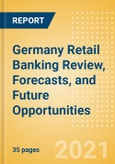This report explores the key trends in the German retail banking sector and offers insight into consumer preferences and changes in behavior regarding financial service providers. It also examines channel preferences and covers overall satisfaction and importance levels of the main banking attributes provided by banks. Furthermore, the report analyzes cross-selling opportunities by comparing the differences between overall product holding versus actual product holding with a customer’s main provider.
The German property market is expected to grow during 2020-25 at a positive compound annual growth rate (CAGR) of 5.2% and credit cards by a CAGR of 3.9% (significantly higher than Germany's comparable countries), but the latter’s growth is set to be slower than the 2015-20 CAGR of 6.1%, albeit due to disruption caused by the COVID-19 pandemic. The slower forecast growth has been impacted by government restrictions and the hesitancy to use credit cards, with many German consumers now shifting to new spending behavior and saving much more rather than spending. Overall, the efficiency of German banks is declining, as shown by rising average cost-to-income ratios (CIRs). The profitability of German banks declined in 2020 due to increasing COVID-19-related costs, but this trend was already in effect before the pandemic due to poor revenues. As a result, German banks' CIRs have shown significant increases between 2015 and 2020.
The German property market is expected to grow during 2020-25 at a positive compound annual growth rate (CAGR) of 5.2% and credit cards by a CAGR of 3.9% (significantly higher than Germany's comparable countries), but the latter’s growth is set to be slower than the 2015-20 CAGR of 6.1%, albeit due to disruption caused by the COVID-19 pandemic. The slower forecast growth has been impacted by government restrictions and the hesitancy to use credit cards, with many German consumers now shifting to new spending behavior and saving much more rather than spending. Overall, the efficiency of German banks is declining, as shown by rising average cost-to-income ratios (CIRs). The profitability of German banks declined in 2020 due to increasing COVID-19-related costs, but this trend was already in effect before the pandemic due to poor revenues. As a result, German banks' CIRs have shown significant increases between 2015 and 2020.
Scope
- German attitudes towards alternative banking show that consumers are showing more willingness to trust alternative providers. Still, at the same time, Germany has recorded the smallest shift in Europe in terms of movement to alternative providers.
- Younger German customers prefer alternative providers, with the most significant driving factors being around rates/rewards, security, and better digital functionality. Conversely, the two areas with the lowest respondent choices were an appealing brand image and environmental, social, and governance (ESG) alignment (6% and 5%, respectively).
- The younger German cohort uses the branch more than those aged 35 and above. Of those 18-34, the top ranked activities for branch visitation among German respondents are account opening, applying for a mortgage, and conducting frequent banking tasks.
Reasons to Buy
- Understand and analyze trends in the German housing, deposit, and unsecured market through past and forecasted growth up to 2025 through the sector's performance compared to other markets.
- Uncover in-depth analysis of market shares across the leading German players while looking at the winners and losers of CIR maintenance.
- Analyze 2021 Financial Services Consumer Survey data by looking at new consumer preferences and behaviors that have emerged while analyzing the key survey highlights.
- Assess critical data points for customer retention and future customer acquisition through three core areas in banking: financial services provider preference and movements, digital and alternative channel preferences, and cross-selling opportunities based on tenure and satisfaction levels.
Table of Contents
1. Executive Summary
3. Market Environment
4. Macroeconomic Environment
5. Competitor Environment
6. Germany Survey Insights
7. Disruptors
8. Appendix
List of Figures
Companies Mentioned (Partial List)
A selection of companies mentioned in this report includes, but is not limited to:
- Sparkassen
- Volksbanken Raiffeisenbanken
- Commerzbank
- Postbank
- ING-DiBa
- Deutsche Bank
- Sparda-Bank
- Comdirect
- Deutsche Kreditbank
- Klarna
- N26








